Industry delves deeper into African frontier
Local content requirements shape operational plans in West Africa as prospects emerge to the East
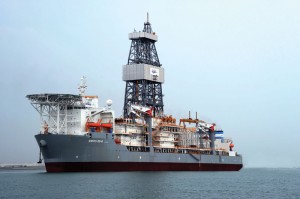
By Joanne Liou, editorial coordinator
On the world map, Africa commands a grand presence, with more than 50 countries that straddle a multitude of climates, terrains and cultures. Into the continent’s vast lands and open waters, the drilling industry continues cautiously to navigate and integrate its activity. From the more established West Coast to the still emerging East Coast, oil companies and drilling contractors have an active future. “There is a lot planned for Africa – long term and short term,” Jan van Bohemen, senior director of marketing and contracts for Ensco, said.
There is a consensus that the demand for rigs and the level of activity is on an upward path. Baker Hughes’ international rotary rig count reflects Africa’s positive growth, with July’s count at 105 rigs, up from 61 the previous year. The last time the continent reached triple digits was in 1985.
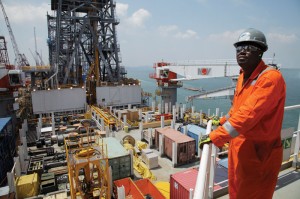
For the offshore market, growth is expected to accelerate. “Ten years ago, we were at 20 floaters under contract,” Mr van Bohemen stated. “Now we have about 35 floaters under contract (East and West Africa), and next year alone, they require another 10 or 12 floaters between East and West Africa. Angola alone will account half of that.”
The growing market is not without its challenges. Before taking a leap into the African frontier, companies proactively plan for an unavoidable frame of regulatory and logistical issues that impact overall operations. “We see a lot of challenges ahead,” Stephen Mair, commercial manager of Africa for KCA DEUTAG, said. “For example, in Nigeria, new laws are getting much stricter on the level of local content, not just in the services you’re using but also the company itself. Now it’s a requirement to have a majority Nigerian shareholder.”
The effects of regulations trickle into logistical challenges, including clearing equipment through custom and training of rig crews.
Although many of the operating challenges in Africa are inherent to the industry, wherever companies operate, this region does appear to require more rigorous, proactive planning upfront. To help meet the needs and requirements of clients and government bodies alike, advanced technologies are being introduced into Africa’s drilling scene, and contractors are tailoring rigs to better suit the environment.
Market
Rig demand
Drilling contractors in Africa acknowledge a growing demand for rigs and believe that the trend will continue. Maersk Drilling has two active ultra-deepwater semisubmersibles in Africa – the Maersk Deliverer is conducting development drilling at the Labito North SC field in Angola, under contract to Chevron until June 2014, and the Maersk Discoverer is drilling exploration wells in Egypt for BP on a contract running until July 2016. A third rig, the Maersk Endurer jackup, is located in Cameroon and under negotiations with an operator for its next contract.
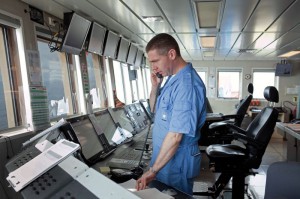
With four ultra-deepwater drillships under construction at Samsung Heavy Industries, including one that has been signed for work in the GOM, Claus Bachmann, deepwater asset manager for Maersk Drilling, hopes to contract two of the remaining three to West Africa. Deepwater Advanced II, III and IV will be delivered from the rig yard in 2013 and 2014. “We see all indications of increasing demand for deepwater units, and we feel confident that it will only be a matter of time before we have managed to close up contracts for the remaining three drillships we are building,” Mr Bachmann stated. “The increase in activity is clearly reflected in the number of deepwater rigs in Angola and Nigeria, which has increased from eight in 2000 to the 21 floaters currently working in the region. We also believe that there is a large potential for further demand where the recent Cameia discovery in Angola might be the start of a much bigger exploration story in West Africas pre-salt area.”
With onshore activity spanning North Africa, West Africa and East Africa, KCA DEUTAG is focusing more on large field development programs. “We just started moving from exploration drilling into development,” Rodrigo Rendon, head of business development for KCA DEUTAG, said. “We have gone from exploring a few wells into long-term field development contracts.” More plans for KCA DEUTAG are moving toward North and East Africa countries, such as Algeria, Uganda, Kenya and Mozambique.
“East Africa in particular is an interesting area of growth, and we’re seeing a lot of our clients heading in that direction,” Mr Rendon added. The company’s clientele – including Statoil, Tullow, Total and Eni – are all expressing interest in East Africa, he said.

Dayrates
Dayrates have noticeably been on the rise. “We have seen increasing rates for West Africa,” Mr van Bohemen said. The demand for rigs is putting pressure on the market, and he believes both deepwater units and jackups will benefit from higher dayrates. “We’ve seen the move of the jackup market to higher-spec jackups, and we’ve seen their dayrates increasing from $60,000 to $100,000/day.”
Ensco’s dayrates for its current operations in Angola range from the mid-$270s to low-$520s, while Pacific Drilling’s dayrates fall around $475,000 in Nigeria.
Ensco has two drillships and one semisubmersible active in Africa. ENSCO DS-1 and ENSCO DS-2 are both offshore Angola operating for Total in block 17. The dayrate for ENSCO DS-1 is low-$350,000 while ENSCO DS-2’s dayrate is mid-$460,000. The ENSCO 5001 semi is operating for Maersk Oil in Angola at a mid-$270,000 dayrate and will soon relocate to South Africa to commence a two-year contract in October with PetroSA to drill five wells. The Ensco DS-6 will mobilize to Angola to commence a five-year contract with BP at a low-$520,000 dayrate.
Challenges
Varying regulations
The regulatory landscape of the drilling industry in Africa presents challenges that often aggravate operational logistics – importing equipment, having available support services or obtaining work visas. The challenges are not isolated to Africa; however, companies are more vigilant to comply with ever-changing requirements of each individual country.
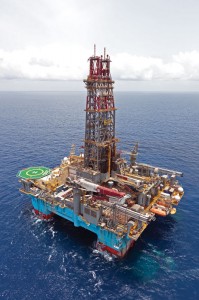
“One day it can be one sequence of events that have to take place before you can obtain a work visa for an expert employee, and then the next day the sequence is changed,” Mr Bachmann said. “Not one day is the same as the day before.” New and varying regulations can delay the process by two to three weeks, which means personnel might need to spend more time offshore until a replacement’s visa is approved.
In addition to people, equipment and spare parts undergo a process to enter the country. In the GOM, obtaining a spare part from a local service company onshore can take as little as one day, but in Africa the same process can take weeks. “Spare parts coming into the country can get stuck in customs for two weeks,” Mr Bachmann stated. “It varies from day to day how long it is going to take to get spare parts through customs and on to the rig. It’s not the same as operating out of Houston in the GOM, Norway or Denmark, and you have to be prepared for that.”
The approval process is often met with disruptions that add more time to the wait. “We have had requests for payments, which we couldn’t understand and, in our eyes, were not applicable,” Cees Van Diemen, senior vice president operations for Pacific Drilling, explained. “At one stage, we operated for five weeks without getting any spare parts into the country, but luckily we never shut down and had all the parts we needed.” Operators and some contractors, such as Pacific Drilling, are working with local authorities to improve processes and the regulations that are affecting operations. “They’re open to our comments, but there are many rules which have to be turned before changes are made,” Mr Van Diemen said.
Local content requirements
Each country presents differing local content requirements that call for careful planning and implementation. Since the industry itself is still developing a presence in some countries, resources – in people and services – are limited, and companies must cultivate their livelihood within the country it operates in.
In Angola, drillers are required to employ up to 70% locals, which puts pressure on training crews to ensure competency. “The burden is on all of us to train and develop more offshore personnel,” Mr van Bohemen explained. “Workforce management is critically important and will determine who is recognized as the top performer in the offshore space.”
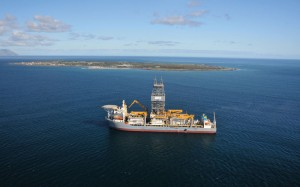
Pacific Drilling’s operations involving two newbuild drillships in Nigeria required more than 50% local content from the start. The Pacific Bora began a three-year contract with Chevron in August 2011 for development work in the Usan Field, about 62 miles offshore Nigeria. Following the Pacific Bora, the Pacific Scirocco commenced a two-year drilling program with Total in December 2011 for development work in the Egina field, about 90 miles offshore Nigeria.
“We definitely tailored our training and our manning on board to comply with local content requirements,” Mr Van Diemen said. “We have had to significantly increase the amount of oversight and the amount of training. There are not many people available who have the experience with the type of equipment we have.”
Training
Companies are responding to local content requirements in training and in numbers to safely carry out operations in the short- and long-term future. Investing in local talent is helping to establish a work force that meets company expectations. “Training and oversight are the keys to success,” Mr Van Diemen stated. “We like to hire from the bottom up and train them ourselves so they can learn our standards so that they can be promoted fairly quickly and capture all the required knowledge and practice.”
Some companies, such as Maersk and Ensco, are agressively hiring additional local crews that are being trained to ensure workers are fully versed on their safety management and operating systems. Maersk is doubling crews – also referred to as shadow crews – that are being trained so the company can ensure workers are competent without having to disrupt operations.
Companies are also establishing local training centers to help serve the region’s growing work force. KCA DEUTAG provides training in Nigeria using DART Services, the company’s approach to drilling operations training. The services offer simulator-based well control training and simulations with drilling equipment for rig crews and operators. Maersk’s Port Harcourt training facility specializes in safety and survival training, but drillers and assistant drillers are sent to Denmark for well control training.
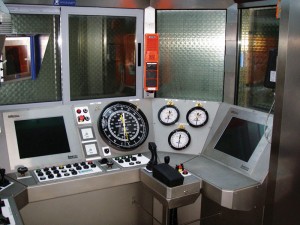
Technologies
Rigs
Taking into consideration the geography and regulations that characterize Africa’s drilling market, drilling contractors tailor rigs with improved efficiencies, equipment and safety measures to meet the requirements of not only the government but the environment as well.
“In North Africa, you have to be prepared for very remote operations in the middle of the desert. In West Africa, like Nigeria and Gabon, you have to be prepared for a remote jungle environment,” Mr Mair explained. Onshore, KCA DEUTAG has four rigs operating in Algeria (rising to six by Q1 next year), one rig operating in Gabon and seven rigs operating in Nigeria. There are further plans to mobilize an additional rig by the start of 2013. Offshore, the company has one jackup in 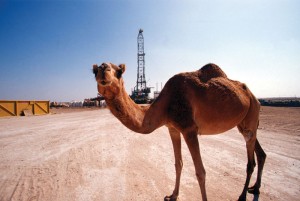 Mozambique, one jackup destined for Gabon in Q4 this year, one self-erecting tender barge that will operate in Ivory Coast, and the company also operates a client-owned platform rig in Angola. Recovering from the 2011 conflict in Libya, KCA DEUTAG is in discussions with former and prospective clients regarding its 15 rigs in the North Africa country.
Mozambique, one jackup destined for Gabon in Q4 this year, one self-erecting tender barge that will operate in Ivory Coast, and the company also operates a client-owned platform rig in Angola. Recovering from the 2011 conflict in Libya, KCA DEUTAG is in discussions with former and prospective clients regarding its 15 rigs in the North Africa country.
Across the African continent, KCA DEUTAG’s client base tends to be large and medium-sized international IOCs, for example: BP, Chevron and CNR International. In some countries like Nigeria and Libya, where the company has had a longer presence, local operators make up half its client base.
Designed for the North African market, KCA DEUTAG’s Speed Rig incorporates high mobility and a moderate level of mechanization with joystick control. Over flat terrain, the rig move time is about 36 hours, and the rig transports on 28 trailers, according to Mr Rendon.
“The current design can be modified so it skids, and the other main advantage is that the electronics and main equipment is all integrated because it is from the same manufacturer,” he explained. KCA DEUTAG’s sister company, Bentec in Germany, manufactures the Speed Rig and its main components, including the top drive and drawworks. Currently, one Speed Rig, the T220, is operating in Algeria, while two others – T222 and T223 – will commence operations in Algeria in Q4.
Pacific Drilling’s two newbuild drillships, the Pacific Bora and Pacific Scirocco in Nigeria, have also been designed to accommodate the offshore environment and regulations. “If you talk about landing strings for casing, everything is set up for 10,000 to 12,000 ft of operating water depth,” Mr Van Diemen said. Additional air-conditioning units have been installed in crew cabins, as well as the work area, to account for the environment’s hot weather.
Considering challenges of importing and transporting parts as needed, the drillships also boast redundancies in equipment. Although space is valued on the rig, Pacific Drilling’s customers are choosing to keep equipment on the vessel instead of having them onshore, Mr Van Diemen explained. After spare parts and equipment clear customs, supply boats to transport them are not always readily available. “Supply boats provided by clients only sail during the daytime,” he added, and scheduling conflicts or security issues sometimes prevents boats from sailing out of the country.
Pre-salt, subsalt drilling
Presalt drilling, which so far has been more commonly associated with Brazil and the Gulf of Mexico, has recently become more prevalent in West Africa. Eleven pre-salt blocks have been awarded offshore Angola, with BP, Cobalt, CoP, Eni, Repsol YPF, Statoil and Total all picking up acreage, according to Ensco. The ENSCO DS-3 drillship recently completed a pre-salt/subsalt project for Petrobras offshore Angola. ENSCO 5001 is drilling subsalt wells for Maersk Oil, and ENSCO DS-6 is also expected to commence drilling subsalt wells in 2013 offshore Angola.
“In Angola, the operators are very confident. Geologists from Petrobras have said, ‘What we see here is identical to what we see at home (in Brazil),’” Mr van Bohemen explained. “It’s very encouraging because we know how successful Brazil is in the subsalt. There’s some indication that this is going to take off, and that’s why operators are now focusing on West Africa, not just Angola.”
Pacific Drilling notes that although they have yet to participate in a pre-salt project in Africa, their rigs are equipped and ready to drill pre-salt wells.
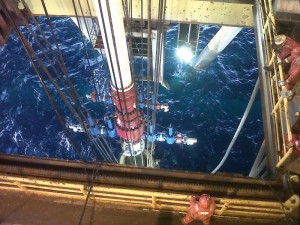
Weatherford also draws from its presalt experience in the western hemisphere and is looking into applying similar technologies to presalt formations in Africa. “We have done MPD with presalt drilling in Brazil,” Essam Sammat, business development manager – managed pressure drilling services for Weatherford, said, “and we are investigating using the MPD system on the presalt formations in West Africa within the next year.”
Low ROP, borehole division and a corrosive environment are all issues associated with pre-salt formations, and all can be addressed through MPD, according to Mr Sammat. Since his company first ran an automated system in West Africa in 2008, their MPD portfolio has grown to include operations in Libya, Egypt, Tunisia, Nigeria and, most recently, Ghana. “MPD is finding its way in with Africa,” he said, where deepwater wells have high risks of kicks and losses, low ROP in challenging formations, higher pore pressure and lower fracture gradient.
In Q1 this year, Weatherford provided MPD services for 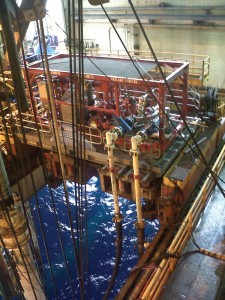 a fourth-generation semisubmersible offshore Ghana in a water depth of 5,500 ft. The operator also used their proprietary continuous circulation system to maintain equivalent circulation density when making or breaking the drill pipe connections. “The Ghana well had a high-pressure zone that they couldn’t drill in the past. Also, with an inherently unstable zone, the well would collapse, and they needed to temporarily abandon this zone and drill a sidetrack. This is not cost effective, especially when you drill these wells from a semisub with a high-cost day ate,” Mr Sammat explained.
a fourth-generation semisubmersible offshore Ghana in a water depth of 5,500 ft. The operator also used their proprietary continuous circulation system to maintain equivalent circulation density when making or breaking the drill pipe connections. “The Ghana well had a high-pressure zone that they couldn’t drill in the past. Also, with an inherently unstable zone, the well would collapse, and they needed to temporarily abandon this zone and drill a sidetrack. This is not cost effective, especially when you drill these wells from a semisub with a high-cost day ate,” Mr Sammat explained.
The previous Ghana well was drilled about 400 meters away, and it was abandoned due to the inability to reach TD. The well had higher pore pressure but lower frac gradient, which made the drilling window very narrow. “The only way to get through this narrow window is using technology such as MPD,” Mr Sammat said. By applying lessons learned from previous MPD applications in Africa, the system was able to reach TD at about 4,500 meters – a depth that had never been reached before in that locality, Mr Sammat explained.
MPD is providing speed and precision to manage some of Africa’s most complex trouble zones in downhole pressure environments. “An MPD system is often not an option anymore; it’s a requirement,” Mr Sammat stated. “It would not be possible to drill these ultra-deepwater wells with a narrow drilling window without an MPD system.”

Mindful of challenges that span operations, the lack of MPD exposure in the region required more training, he said. Training included use of an MPD simulator and working with key personnel to ensure understanding of the system and individual roles. Limited space on the rig for MPD equipment, specifically the MPD manifold, also required a platform to be installed on the BOP cart in the moonpool area. Weatherford is in the process of rigging up an MPD system for its first HPHT well in West Africa, which is expected to commence drilling in Q4.
The African frontier presents inviting opportunities for the oil and gas industry, and companies are stepping up to the plate to meet growing demands. Beyond the continuing activity in West Africa, exploration activities on the opposite coast are attracting more attention. “We’re going to see Tanzania, Kenya and Mozambique further emerging,” Mr van Bohemen said. “There are numerous opportunities for drilling contractors.”
The diverse continent poses challenges varying from country to country and, at times, from day to day, but challenges are not foreign to the industry. Instead of retreating to familiar grounds, companies are taking a proactive approach with comprehensive planning, compliance and investments to build a foundation for the Africa market to flourish. “If you as a company are capable of attracting the right people, you can have a very good operation (in Africa),” Mr Bachmann stated. “We are all, more or less, in the same boat, so we need to make it happen. It is challenging – no doubt about that. That’s what also makes it interesting.”




